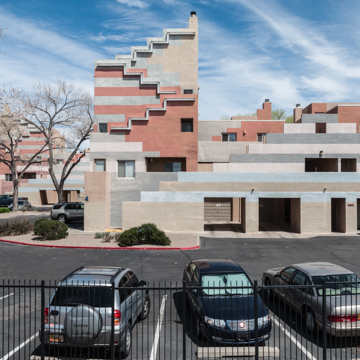The Beach Apartments at once celebrate the bygone era of Route 66 and work to redevelop downtown Albuquerque in a very different age.
The Beach Apartments are economical structures of wood frame and stucco built with municipal bonds; their 74 units mix market-rate and subsidized low-income rentals. Named after Tingley Beach, an adjacent manmade pond, the apartments are wedged between Central Avenue/Route 66 and the 18-hole golf course of the Albuquerque Country Club. To Antoine Predock, the site seemed to “straddle a cultural fault line” between the Hispanic low riders cruising Central Avenue and the fairways of Albuquerque’s elite. Caught between two worlds, the Beach Apartments overlook the golf course with subdued elevations mimicking the prevailing Mediterranean style of the Country Club neighborhood, yet turn their primary and much more vibrant face to Route 66.
This main elevation, 750 feet long, clusters into stepped masses that suggest both an artificial mountain range to be read at the speed of a passing automobile, and a Southwestern village of buildings and connecting parking lots, now scaled to humans on foot. Polychromatic stucco unrolls across the stepped and terraced elevations in bands of tan, grey, sage green, light blue, and terra-cotta red. Accented at night by neon lighting, the scheme intentionally mediates the patterning of Navajo blankets and the imagery of Route 66 motels, with their highway signs and motor courts. Architecturally, the Beach Apartments are indebted to the lessons of Learning from Las Vegas. They are also, paradoxically, an early example of Albuquerque’s ongoing municipal effort to counter the patterns of suburban dispersal and revive the city core with housing along the Central Avenue corridor.
References
Mulard, Claudine. “Predock.” Architecture intérieure créé, no. 233 (December 1989-January 1990): 104-125.
Predock, Antoine. “Antoine Predock.” A+U (Architecture and Urbanism) 88, no. 11 (November 1988): 75-130.
Venturi, Robert, Denise Scott Brown, and Steven Izenour. Learning from Las Vegas. Cambridge: MIT Press, 1972.














